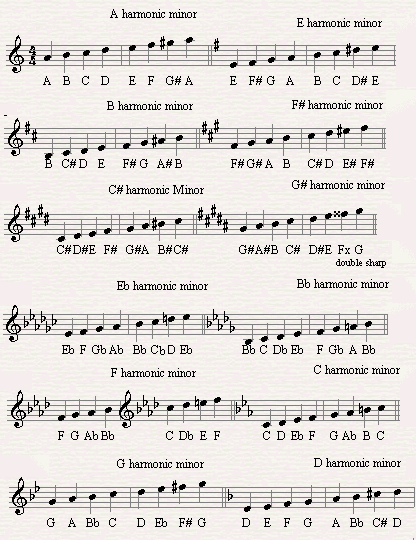


The chords of the key generated by the A minor harmonic scale is as follows: Notice how this scale alone already has a pleasant flavor. Try playing this scale repeatedly to feel the melody. See the shape of the harmonic minor scale of A (the seventh major degree is highlighted in red) below: A harmonic minor scale: This change provided a very interesting sound. This seventh major degree on the minor harmonic scale increased the distance between degrees 6 and 7, shortening the distance between degrees 7 and 8. Notice how the only difference is in the seventh degree (in this case, the G note).
Notes from the Am Harmonic scale: A, B, C, D, E, F, G#. Notes from the Am Natural scale: A, B, C, D, E, F, G. On the natural minor scale, the seventh degree is minor, while in the harmonic minor scale, the seventh degree is major.įor you to see this difference, let’s use the natural A minor scale and the A minor harmonic scale as an example. The only difference between the two is in the seventh degree. Our next article will go into the finer points of the melodic minor scale, how it differs from the natural and harmonic minor scales and common uses for the melodic minor scale in modern music.The harmonic minor scale is very similar to the natural minor scale. Sometimes, that larger interval from F to G# (an augmented 2nd, equivalent to a minor third) sounds too abrupt, and this is where the melodic minor scale comes in to play. This is, again, why the harmonic minor was such a staple of the Classical and Romantic era, and why we still use it so frequently today: it allows us to be in a minor key, with all the benefits that entails, but also to get the benefits of the strong V to I relationship that exists in the key of A major. Harmonic minor is essentially swapping the G for a G# to sound more like A major. In the key of A major, the V chord is E major, which has E G# and B in it. Sometimes a cadence on “a” (the i chord) will not sound convincing enough without a leading tone, or a half step lead in to the root. By changing G to G#, we not only create a leading tone for A, but we also create a stronger V chord, moving from e minor to E major.Īnother way to put it is this: in the A natural minor scale, G and B are a whole step away from the root, A. The G# is the most important when dealing with the V (5) chord of A minor and A major (E). And if we look at A minor compared to A major, it makes sense. Using the harmonic minor instead of the natural minor allowed them to give stronger resolutions and cadences within their works. Historically, composers like Mozart used the harmonic minor scale to do exactly that. However, the biggest reason why we use the harmonic minor instead of the natural minor, is that it allows us to sound like we are in the parallel major, particularly when we are dealing with cadences or tension resolution. 
The E-F and G#-A sound is very characteristic of this type of music. There are a few reasons why we may want to use the Harmonic Minor scale, and one of them is to give us a Middle Eastern feel to our music.

To make it harmonic minor we raise the G one half step to a G#, which in A harmonic minor would give us: A B C D E F and G#. For instance, the key of A natural minor includes the notes: A B C D E F and G. All that we need to do to get to the harmonic minor from the natural minor is simply raise the 7th degree by one half step (which is one fret on the guitar, or one key on the piano). The harmonic scale is a simple derivation of the natural minor scale. In this article we will be talking about the harmonic minor scale. In addition to the natural minor scale, there are two other forms of the minor scale: the harmonic minor and the melodic minor.








 0 kommentar(er)
0 kommentar(er)
